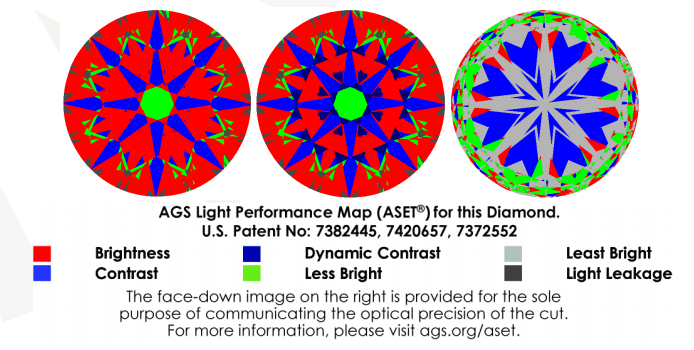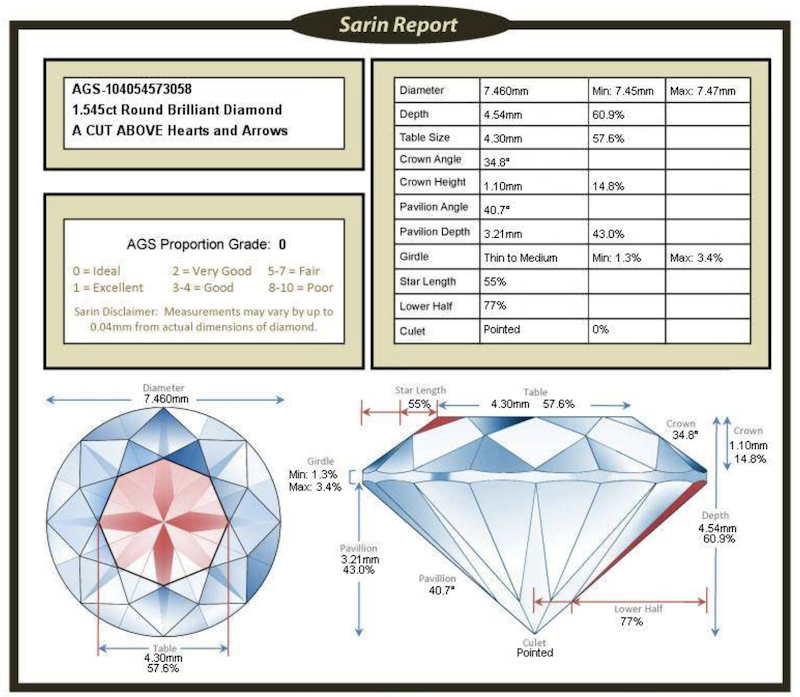Diamond Education
Diamond Light Performance Imaging
In the dazzling world of diamonds, every facet tells a story. While the untrained eye may be captivated by the sheer sparkle of a diamond, connoisseurs and experts delve deeper, seeking to understand the intricate dance of light within the gem. This is where diamond imaging comes into play. With advancements in technology, we now have the tools to peek into a diamond's soul, revealing its true character and performance.
This guide aims to shed light on the significance of diamond imaging, especially in the context of understanding a diamond's interaction with light. As we journey through, we'll uncover why these imaging tools are not just fancy additions but essential instruments in making an informed diamond purchase.
The Science Behind Diamond Light Performance
Diamonds have long been celebrated for their mesmerizing play of light. But what causes this enchanting display? The answer lies in the science of light performance.
When light enters a diamond, it undergoes a series of reflections and refractions. The way a diamond is cut and shaped determines how effectively it can bend and reflect this light. The goal is to have the light enter the diamond, bounce internally, and then exit in a brilliant display. This phenomenon is what we commonly refer to as the diamond's "brilliance."
However, brilliance is just one part of the equation. Diamonds also exhibit "fire," which is the dispersion of white light into its spectral colors, creating a rainbow effect. This is why, under certain lighting, diamonds can flash colors like red, blue, and green.
Lastly, there's "scintillation," which refers to the alternating play of light and dark areas in a diamond as it moves. It's the sparkle you see when a diamond catches the light, creating a dynamic and captivating effect.
Understanding these three aspects—brilliance, fire, and scintillation—is crucial when evaluating a diamond's light performance. And while they can be observed to some extent with the naked eye, specialized imaging tools offer a more detailed and accurate insight, ensuring that you truly get a diamond that shines in all its glory.
Ideal Scopes
- What it is: An Ideal Scope is a simple, handheld tool that uses red and white colors to display light performance in diamonds.
- Why it's important: It reveals where a diamond is leaking light (shown in white) and where it's reflecting light (shown in red). A diamond with minimal light leakage (less white) is considered of higher quality. Black areas indicate light returned at very high angles (light from directly above is blocked by the camera).

Image from Whiteflash.com
Hearts & Arrows
- What it is: When viewed from the top (the crown), a perfectly symmetrical round brilliant diamond will display an arrow pattern, and when viewed from the bottom (the pavilion), it will show a pattern of eight hearts.
- Why it's important: This pattern is an indicator of superior optical symmetry and suggests that the diamond has been cut to exacting standards.


ASET Maps (Angular Spectrum Evaluation Tool)
- What it is: ASET maps use colored patterns to show how a diamond is interacting with light from various angles.
- Why it's important: It provides insights into a diamond's brightness, contrast, and light leakage. Different colors represent different light sources, helping to understand how a diamond will perform in varied lighting conditions.

Sarine Reports
- What it is: Sarine reports provide a comprehensive profile of a diamond, including its cut, symmetry, proportions, and other vital attributes.
- Why it's important: These reports give a 360-degree view of a diamond's characteristics, ensuring that buyers have all the information they need.
- Suggested Image: A sample Sarine report with annotations pointing to key sections.

Sarine Report
HD Images and Videos
- What it is: High-definition photographs and videos that capture every facet of the diamond in detail.
- Why it's important: They offer a clear, magnified view of the diamond, allowing buyers to inspect inclusions, blemishes, and the overall quality of the stone. It's the closest thing to examining a diamond in person.

Screenshot from a Blue Nile Diamond Video
Certification from Recognized Labs
- What it is: A certificate from internationally recognized labs like GIA (for natural diamonds) or IGI (for lab diamonds) that verifies a diamond's attributes.
- Why it's important: It ensures the authenticity and quality of the diamond. Only buy diamonds with certifications from these trusted entities to ensure you're getting what you pay for.
Understanding and utilizing these imaging tools can significantly enhance the diamond buying experience. They offer transparency, ensuring that buyers are equipped with all the knowledge they need to find a diamond that truly resonates with their preferences and budget.
Why Diamond Imaging is Crucial When Buying Online
In today's digital age, more consumers are turning to online platforms to make significant purchases, including diamonds. While online shopping offers convenience and often a broader selection, it also presents a unique challenge: How can you be sure of what you're buying without seeing it in person? This is where diamond imaging becomes indispensable.
- Building Trust: High-quality imaging tools bridge the gap between online shopping and the traditional in-store experience. They provide a transparent view of the product, ensuring that buyers know exactly what they're investing in.
- Informed Decisions: With tools like HD videos and Ideal Scopes, buyers can assess a diamond's quality, cut, and light performance. This empowers them to make decisions based on detailed visual information rather than just textual descriptions.
- Spotting Inclusions and Blemishes: Detailed images and videos allow buyers to inspect diamonds for any inclusions or blemishes that might affect their value and appearance. This level of scrutiny is often more detailed than what one might achieve with the naked eye in a physical store.
- Comparative Analysis: Online platforms often allow side-by-side comparisons of different diamonds. With high-quality imaging, buyers can compare the light performance, cut, and clarity of multiple diamonds simultaneously, ensuring they choose the best option for their budget.
- Enhanced Confidence: Knowing that you've seen every facet of your chosen diamond, analyzed its light performance, and understood its quality metrics instills a sense of confidence. This assurance is invaluable, especially for a purchase as significant as a diamond.
Which Vendors Supply Diamond Light Performance Images & Video
When buying diamonds online, imaging tools are pivotal. Here's a concise breakdown of what top vendors offer:
Whiteflash:
- Provides HD videos showcasing sparkle and brilliance.
- Offers Ideal Scope, Hearts & Arrows, ASET Map, and Sarine Report alongside the diamond certificate.
James Allen:
- Features HD videos for all diamonds.
- Exclusive Hearts and Arrows imaging for their True Hearts diamonds.
Blue Nile:
- Limited to a GemEx certificate for select Astor Diamonds, quantifying brilliance, fire, and sparkle.
Brilliant Earth:
- Only provides basic diamond videos.
Conclusion
Diamonds are not just gemstones; they're symbols of love, commitment, and significant milestones. As such, purchasing one, especially online, should be approached with diligence and thoroughness. Advanced diamond imaging tools have revolutionized the online diamond buying experience, offering transparency, detail, and assurance. By understanding and utilizing these tools, buyers can navigate the digital diamond marketplace with confidence, ensuring that the gem they select sparkles just as brightly in reality as it does in their dreams.
